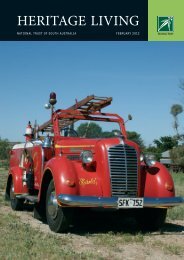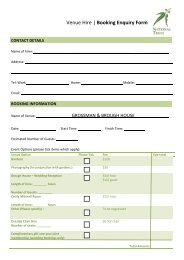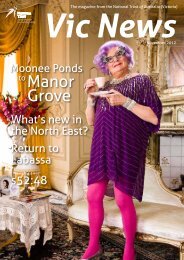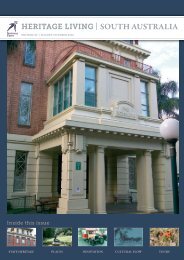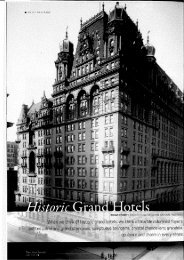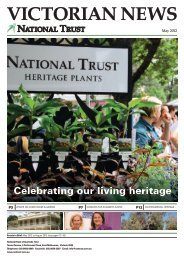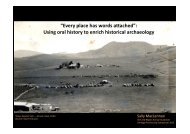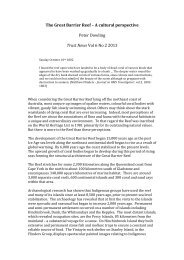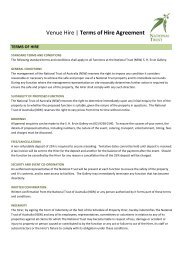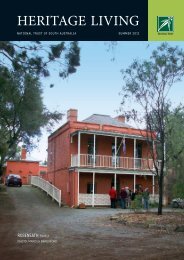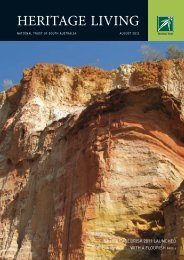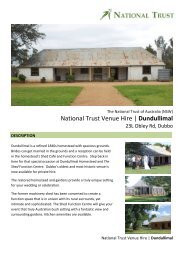Willunga Slate Trail - National Trust of Australia
Willunga Slate Trail - National Trust of Australia
Willunga Slate Trail - National Trust of Australia
Create successful ePaper yourself
Turn your PDF publications into a flip-book with our unique Google optimized e-Paper software.
IntroductionThe unique <strong>Slate</strong> Museum in <strong>Willunga</strong>, South<strong>Australia</strong>, tells <strong>of</strong> the discovery <strong>of</strong> <strong>Slate</strong>, thesubsequent development <strong>of</strong> the industry andthe influence <strong>of</strong> the Cornish Quarrymen and theirfamilies on the social and cultural life <strong>of</strong> the district.The township <strong>of</strong> <strong>Willunga</strong> is testament to theadaptability <strong>of</strong> slate and the ingenuity <strong>of</strong> localresidents in using the readily available material tomeet their needs around their farms and houses,as shown in using slate for ro<strong>of</strong>ing, flooring,paving, fencing, water tanks, garden walls andbook-leaf style bridges and small outbuildings.Beautifully carved slate headstones in the localcemeteries were <strong>of</strong>ten signed by the carver,while some homes still retain their delicatelycarved mantel-pieces. Several fine examples <strong>of</strong>slate carving are on display in the Museum.The slate trail endevours to highlight the varieduses <strong>of</strong> slate around the township <strong>of</strong> <strong>Willunga</strong>and indicates some points <strong>of</strong> interest further afield.Allow 3 hours for a leisurely stroll or enjoy ashorter section.NATIONAL TRUSTSOUTH AUSTRALIAOpening TimesTuesdays: 11a.m. to 4 p.m.Saturday, Sunday andPublic Holidays: 1 p.m. to 5 p.m.Groups, outdoor weddings and other timesby arrangement, phone:(08) 8556 2195<strong>Willunga</strong> <strong>Slate</strong> Museum61 High Street, <strong>Willunga</strong>South <strong>Australia</strong> 5172NATIONAL TRUSTSOUTH AUSTRALIA<strong>Willunga</strong><strong>Slate</strong><strong>Trail</strong>& MUSEUMAcknowledgementsWe appreciate the generous supportand assistance <strong>of</strong> the following:Melinda and Jason McCauley <strong>of</strong> the Alma Hotel, <strong>Willunga</strong>,Deb Tucker <strong>of</strong> Raine and Horne, McLaren Vale,<strong>National</strong> <strong>Trust</strong> Branch members,City <strong>of</strong> OnkaparingaTAFESA Graphic Design students, O’Halloran HillA Brief HistoryThe story <strong>of</strong> <strong>Willunga</strong> slate begins in 1840 with itsdiscovery in the hills behind <strong>Willunga</strong>. A farmer,Edward Loud, was out shooting quail with friendswhen he came across an outcrop <strong>of</strong> slate onadjacent land where the Delabole Quarry wasopened. A primitive village was established thereto house the mainly Cornish quarrymen and theirfamilies who flocked to <strong>Willunga</strong> to work in thequarries. Subsequently, Martin’s and Bastian’sQuarry and the Bangor Quarry were established.By 1870 the slate industry had become a veryimportant part <strong>of</strong> the social and economicdevelopment <strong>of</strong> <strong>Willunga</strong> district.In the 1850s the Port <strong>Willunga</strong> Jetty was built (andlater extended) to assist in transporting the slateproducts to Port Adelaide and interstate ports.The slate was transferred by bullock dray downthe steep hills from the quarries and across theAldinga Plains to the Port. By the 1870s, 20,000ro<strong>of</strong>ing slates were being shipped out <strong>of</strong> Port<strong>Willunga</strong> each week.Some early Observationson <strong>Willunga</strong>“The quaint old Irish people and the quaintCornish folks have all passed on but the voicesand speech <strong>of</strong> the next generation are most likethem. Those quaint ones with their musical voicesand picturesque costumes were grand old people<strong>of</strong> the early days. I remember some <strong>of</strong> themwith their poke bonnets and crinolined dresses,black and paisley shawls – and the men going toChurch in black suits and tall bell-toppers. Howdignified and reverent they all were too”.(Maud Aldam, Reminiscences)“<strong>Slate</strong> tanks were introduced- what a boon to the housewivesthat s<strong>of</strong>t rainwater was.And now from earthen floors,the floors <strong>of</strong> the new homeswere laid with a carpet <strong>of</strong>Blue <strong>Slate</strong>, and whatimmense pride the womentook in keeping those blueslates spotlessly clean. Withwashed walls and clean blueslate floors, how inviting werethose early unpretentioushomes <strong>of</strong> the pioneers”.(Maud Aldam, Reminiscences)<strong>Slate</strong> headstones <strong>of</strong>tenappeared in strange places.One was used for flaggingon a kitchen floor after theperson carving it made sucha serious mistake that it couldnot be used as a headstone.Clearly such a large slab <strong>of</strong>slate could not be wasted!“I regret having to reportquite a string <strong>of</strong> accidentsthat have occurred herewithin the last few days. Onthe 6th inst., as Mr Dawe,jnr, was driving his horsedray, heavily laden withslate flagging, down the hillfrom Delabole Quarry, hishorses became restive, andin endeavouring to restrainthem he was thrown downand his left leg broken by thewheel passing over it. He wasspeedily attended byDr. Jay”.(1867 newspaper report)Patterned slate ro<strong>of</strong>,High Street. (Walk item 16)‘Glantawe’,(Walk item 8)St Andrews Terrace.<strong>Slate</strong> kerbing, Old VictorHarbor Road, <strong>Willunga</strong> Hill.<strong>Slate</strong> fence posts, RangeRoad, <strong>Willunga</strong> Hill.<strong>Slate</strong> fire surround carvedwith fern leaf motif. Privateresidence, <strong>Willunga</strong>.Another accident occurred to Mr. JosephAtkinson, whose wagon, also loaded with slateflagging, was capsized while coming down thehill from Bastian’s Quarry. The driver, in springingfrom the wagon, caught his foot in the reinsand fell amongst the struggling horses, but mostmiraculously escaped with only slight injuries;but one <strong>of</strong> the horses was much injured and thewagon broken. (1867 Newspaper report).Two Fatally Crushed in QuarryThomas Jeffrey Arthur (63) and his son Thomas(19) were killed in Martin’s <strong>Slate</strong> Quarry, near<strong>Willunga</strong>, in November 1936. The men werebarring a cracked rock face about 15 metreshigh when about 600 tons <strong>of</strong> rock began to slide.Showered with fragments the men had evidentlyrun, but were overwhelmed. As the men’s lunchhad not been eaten it was surmised that theaccident occurred in the morning, but thetragedy was not discovered until the eveningwhen Frank Arthur went to look for his fatherand brother.
Points <strong>of</strong> Interestaround <strong>Willunga</strong>1. <strong>Willunga</strong> <strong>Slate</strong> Museum (61 High Street)The <strong>Slate</strong> <strong>Trail</strong> starts at the <strong>Slate</strong> Museum in the stablesat the Courthouse and Police Station. Note the slaterain-water tanks outside the Museum. <strong>Slate</strong>-pavedgutters can be seen on the side <strong>of</strong> the Victor Harborroad about 100 metres up Old <strong>Willunga</strong> Hill.2. St. George StreetSt. Joseph’s Roman Catholic Cemetery, Church andSchool. Many <strong>of</strong> the slate headstones were carved byW. Hawken or John Richards jnr, whose prize-winning slatecarving is displayed in the <strong>Slate</strong> Museum. The Church(1848) is the oldest continuously-used church building in<strong>Willunga</strong>.No. 16 St. George St. was built in the early 1850s for quarrymenNicholas Male and Frederick Martin. In the 1870s itwas home to the nuns from the Catholic School attendedby children <strong>of</strong> the Irish slate quarrymen.No. 22 St George St. was the home <strong>of</strong> Richard Polkinghornewho planted the oak tree in the 1860s. His brotherThomas was co-owner <strong>of</strong> Martin’s slate quarry in the late1840s. Note the wooden slab shed across the street.3. Sibly House (8 St. Mary’s Street)Home <strong>of</strong> slate quarryman Samuel Sibly. Several Siblymen worked in the <strong>Willunga</strong> slate quarries. JosephSibly was manager <strong>of</strong> the Delabole Quarry from 1867to 1872. His son John died from injuries sustained in aquarry accident in 1896.4. St Mary’s StreetNo. 15 (St. Mary’s Lodge) was the home <strong>of</strong> Thomas Martin,quarry owner and operator – his home reflected hisposition in <strong>Willunga</strong>. <strong>Slate</strong> was used extensively in thegarden landscaping.Further along is the Reed family cottage. Note the hugeslate slab walls on the shed. Cliff Reed was the last <strong>of</strong> thequarrymen - his slate-splitting tools are displayed in the<strong>Willunga</strong> <strong>Slate</strong> Museum. On the corner <strong>of</strong> Church Street and St.Mary’s Street are a sheet slate fence and book-leaf slate shedonce owned by Thomas Martin.5. Spargo’s Cottage, Bell Tree and Culvert(3 St. Judes Street)Quarryman Richard Spargo built this cob cottage in themid-1850s. After his death from emphysema in 1871 hiswidow Grace supported the family by growingvegetables in the large garden. The Methodist Church Bellis nearby in the large redgum tree. Opposite Spargo’scottage is a modern slate culvert built in the traditionalbook-leaf style, with no mortar.6. Wesleyan Church and Cemetery (St. Jude’s Street)The Wesleyan Church was attended by many slate quarryworkers and owners, and their families. Their spiritedrendition <strong>of</strong> the favourite old Cornish hymns was renowned.The cemetery contains many slate headstones carved byGeorge Sara, also two slate sarcophagi, marking the burialsite <strong>of</strong> members <strong>of</strong> the Bastian and Williams family.7. Arthur’s Cottage (34 St. Andrews Terrace)The Arthur family lived here for two generations. Two Arthurmen (father and son) were killed in a quarry accident in1936. Note the two slate water tanks at the side, the slatewindow sills and small side-panes on the windows.8. ‘Glantawe’ Residence (20 St. Andrews Terrace)The ‘house <strong>of</strong> slate’ was built in 1925 for Basil Dunstan,manager <strong>of</strong> the <strong>Willunga</strong>-Bangor (later <strong>Australia</strong>n <strong>Slate</strong>Quarry) Company. It was designed by his father JohnDunstan an architect who purchased the Bangor Quarryin 1917 and set about reviving the industry. It is a 14-roombungalow built mainly <strong>of</strong> panels <strong>of</strong> sheet slate in heavytimber frames, with some red brick sections. Internal andexternal walls, and some ceilings, are <strong>of</strong> grey slate. Coursedslate decorates the brick walls, columns and chimneys. Thegarage walls and fence are built <strong>of</strong> slab slate panels.9. Dawe’s Residence (19 St. Andrews Terrace)This elegant two storey house with a high pitched slatero<strong>of</strong> was built in the late 1850s by George Sara, the leadingbuilder <strong>of</strong> the district, for Sampson Dawe ex-owner <strong>of</strong> theDelabole <strong>Slate</strong> Quarry.10. Nos. 13 & 9 St. Andrews TerraceAn early book-leaf style slate building and the 1850shome <strong>of</strong> <strong>Willunga</strong>’s bailiff William Cheesman,respectively. (Cheesman headstones can be seen inthe <strong>Slate</strong> Museum). Opposite is St. Stephen’s AnglicanChurch (1884) with original slate ro<strong>of</strong>.11. Show Hall, (Main Road)Opened in 1890, the Agricultural Hall was the venuefor the district’s popular Agricultural and HorticulturalShows, at which local slate was displayed.12. Alma Hotel and early <strong>Willunga</strong> store (Hill Street)The hotel opened in September 1856. The early slateverandahs and internal floors remain. The cafe anddelicatessen building nearby has operated sincethe 1890s as a store, and refreshment shop for touristbuses. Note the original slate ro<strong>of</strong>.13. St. Peters Terrace.Several distinctive quarrymen’s cottages can be seen(Welshford’s at No. 3 and Samuel Heysed’s at No. 13).St. Anne’s Lodge (No. 7) was built in 1851 for Dr.Richard Jay who was always ‘on call’ for the quarrymenand their families.14. Waverley Park ( St. Peters Terrace)Thomas Smith Kell established a house and dairy herearound 1846. The early dairy outbuilding behind thehouse, built <strong>of</strong> finely cut book-leaf slate, is <strong>of</strong>particular interest. Waverley Park later belonged toJohn Allen, who owned the Delabole <strong>Slate</strong> Quarryuntil 1903 and was Chairman <strong>of</strong> <strong>Willunga</strong> DistrictCouncil for many years.15. Russell’s & Minko Wines, Tall Poppy(13 & 17 High Street)No. 13 is an early blacksmith’s home, boot-maker’s shopand Primitive Methodist manse with original slate ro<strong>of</strong>,slate window sills and slate floor. No. 17 was a butcher’sshop from the1860s to 1955, with original verandahstones, a large cellar and a slate mantelpiece carvedby Thomas Dennis Jackson.To Mclaren Vale11Aldinga RoadTo Aldinga87Methodist StreetMain RoadSt Andrews TerraceHill Street12Kell Street13St Peters Terrace151710 1618Moore St919653Church StSt Marys StreetHigh StreetSt Judes StreetSt Lukes<strong>Willunga</strong> Golf CourseStreetBishop Street Bridge StChapel St42St George Street14Kirk St20St Matthews StreetNorthFootbridges211StartTo VictorHarbor16. Shop and Residence (22 High Street)An early shop and general store for nearly 100 years.Inside the rear <strong>of</strong> the shop is a small Gothic windowused by slate quarrymen cashing their pay cheques afterwork. Note the unusual patterned slate ro<strong>of</strong>.17. Cafe Restaurant (27 High Street)Opened in 1868 as a Primitive Methodist Church. Theslate foundation stone from the original Church standsnear the side entrance. The Gallery and shop next dooroccupy an 1860s building with its original slate ro<strong>of</strong> anda slab slate floor.18. Oddfellows Hall (35 High Street)As the town’s first cultural centre (1863) the Hall was apopular venue for lectures, concerts, recitals and publicmeetings and was the centre <strong>of</strong> community life for thequarrymen and their families. During an 1866 concert‘an original song “<strong>Slate</strong>, <strong>Slate</strong>, <strong>Slate</strong> or the Delabole Hat”was sung by Mr. Hutton, who convulsed the audienceby having a slate hat brought on the platform, theallusions to which seemed to be thoroughlyunderstood and enjoyed by those present, and wasvociferously encored’.19. Hall (38 High St)Built in 1870 for the Church <strong>of</strong> Christ, with original slatero<strong>of</strong> and outbuildings, and used for a variety <strong>of</strong>community purposes including a POW Depot, Red Crossand CWA meeting rooms, and then as a Masonic Hall.TunnelVictor Harbor20. Bassett Boys’ Schoolroom (19 St Luke’s Street)A purpose-built schoolroom, opened in 1862 by JamesBassett, with original slate ro<strong>of</strong> and floor.Colville RoadToBangorQuarryRoadSt Johns TerraceTo Martin’s& Bastian’sQuarry21. Bridge and Cottages (St. James Street)The deep culvert-type bridge is built book-leaf style <strong>of</strong>local slate and named after basket-weaver ThomasMorton. Upalong Cottage (No.19) was the 1850s home<strong>of</strong> Richard Mortimer, quarryman and builder, followedby the Morton family. McCaffrey’s Cottage (No. 21) wasthe home in the late 1850s <strong>of</strong> James McCaffrey,an Irish quarryman.Please respect the privacy <strong>of</strong> the property owners.



